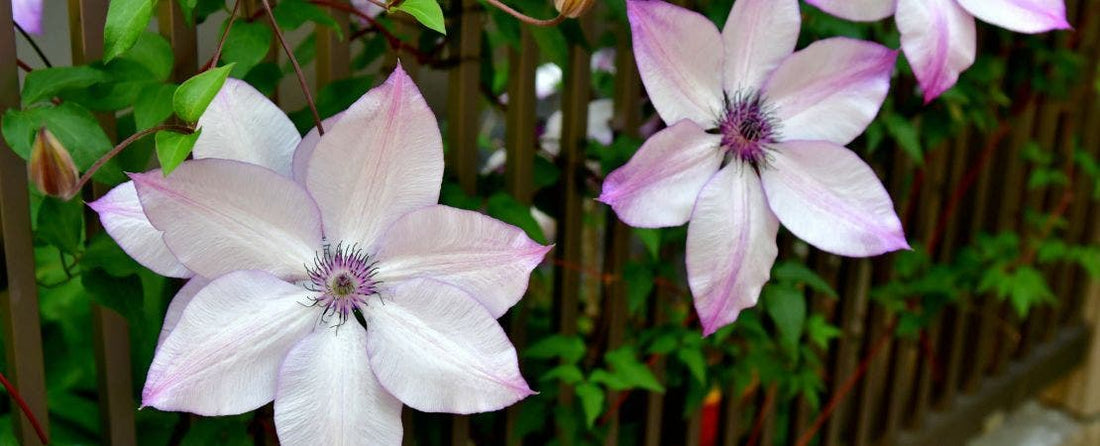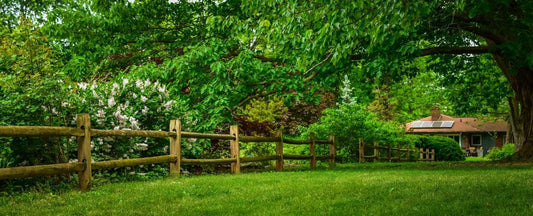Tips for Pruning Clematis Vines

How to Prune Your Clematis
To determine when to prune your clematis, it's crucial to know which pruning group your plant belongs to. Clematis varieties are divided into three main groups, each with specific pruning times and methods. If you bought your Clematis from Wayside Gardens, our website or catalog will tell you whether the plant is part of Group 1, 2, or 3. The group dictates the ideal time for and extent of pruning clematis. If your specific clematis variety isn't being offered this season, give us a call and we'll happily look up the group your clematis variety belongs to. You may also be able to identify the group by your clematis’s blooming habit.
Shop Clematis Vines from Wayside Gardens
Pruning Group 1 Clematis: Early Spring Blooming
These clematis varieties bloom in early spring on old wood. They're the heralds of spring, bringing early color to the garden. Pruning should be minimal, focusing on removing dead wood and tidying up after the blooms have faded. Avoid heavy pruning to not lose next season's flowers.
- Blooms in early spring from buds set the previous season on old wood; doesn’t die back in winter.
- Prune only when needed, after spring blooming is complete.
- Group one clematis tend to bloom early in the spring and should only be pruned sparingly. After the colorful bloom-show is over you can give them a light pruning. All you want to do is clear out dead wood and keep the stems tidy.
- Since this group blooms only on old wood, cutting too low or too early in the season could cost you flowers!
Pruning Group 2 Clematis: Repeat Blooming
This group includes varieties that bloom twice, first on old wood in late spring and again on new wood in late summer or fall. In March, before the growing season starts, prune to remove dead wood and cut back stems to a pair of strong buds, encouraging healthy new growth without sacrificing blooms.
Typically includes reblooming clematis varieties that produce flowers on old wood in late spring into early summer and often bloom again on new wood in late summer or fall.
Group two clematis should be given a moderate trim. Since they bloom on old and new wood alike, you want to trim just enough to encourage new growth, but without losing any promising buds.
This group tends to bloom toward the middle of the season, setting flowers on old wood in late spring to early summer and then reblooming on the new wood through late summer or even into early fall. This group of clematis is a bit more forgiving even if you prune a bit too harshly, you can still enjoy a late season rebloom.
Pruning Group 3 Clematis: Summer or Fall Blooming
These varieties bloom on new growth and can be cut back hard each year in March to about 12 inches from the ground. This group is the most straightforward to prune, as they robustly return each year with blooms on this year's new wood.
Blooms on new wood in the summer and fall; dies back to the ground over winter.
This group goes dormant in the winter, letting the stems die off, and then stems grow anew each spring.
Clematis in group III will come back strong each year with blooms on new wood. Since they re-grow from their pruned 12 inches and reach their mature size each summer, they tend to be the last to flower, opening in late summer or fall.
IMPORTANT Special Pruning Instructions for Your New Clematis
First Season Clematis Pruning
Every variety, regardless of group, should be cut back to about 5 inches from the ground in late winter/early spring the first year after it is planted. While it’s not a must, your clematis will certainly still grow and flower without this first season trim but if you want a bushier, stronger, tighter growth habit, with flowers that begin at the base of the plant instead of beginning 4 feet off the ground, cut every stem back to 5 inches from the soil. Don't worry about leaving buds; Clematis handles that sort of thing with underground growth.
Note that if your Clematis is in Group 1 or 2, this first-year pruning means that you won't get blooms this first year. Since these groups bloom on old wood, the previous season's growth, you will lose one season of color. But the promise of top to bottom blooms on your clematis vine for years to come will more than make up for the one early season without flowers.
Reinvigorate even your long-established vining clematis by cutting every stem that's coming out of the ground to 5 inches tall. Even if your clematis has been twining up a trellis for years without a trim, this pruning will revive the blooms all along the stems. Maybe you have noticed fewer blooms each year or, perhaps, flowers only at the very end of the stems? This pruning will refresh that floriferous growth.
Second Year's Growth Clematis Pruning
A further second year pruning is recommended for clematis in Groups 1 and 2. While, again, not required, it will improve the lush, many-stemmed, blooming of a happy clematis. In this second year you would prune all stems back to about 3 feet from the ground in late winter/early spring. You will have blooms this year, because everything above 5 inches from the ground is old wood, based on your first season pruning. With this method your clematis won't grow tall as quickly, but it will encourage more shoots for a fuller, superior-flowering clematis for years to come. But if you're ready to plant it and forget it, clematis are very forgiving and will flower beautifully for many seasons without this early pruning.
If your Clematis is in Group 3, skip the second-year pruning. Your variety blooms on new wood, so this pruning is unnecessary.
Once you know which group your clematis belongs to and have that first-year trim out of the way, it’s easy to keep this woody climbing perennial vine looking its best and blooming like crazy with the appropriate pruning. Just a few minutes once a year will yield you armloads of flowers for many seasons. Clematis have many uses in the garden and landscape, from hiding unsightly views behind the fence to decorating garden trellises and stylish structures.






